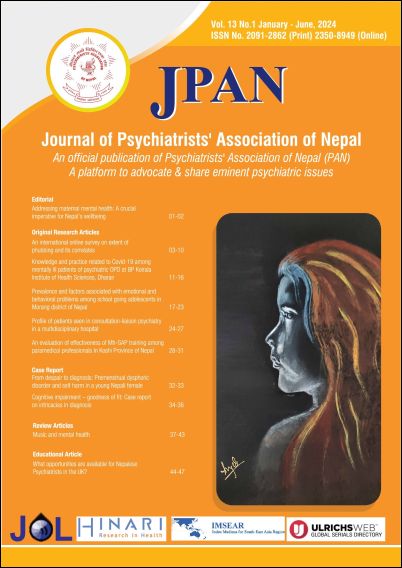Prevalence and factors associated with emotional and behavioral problems among school going adolescents in Morang district of Nepal
DOI:
https://doi.org/10.3126/jpan.v13i1.68185Keywords:
Emotional and Behavioral problem, Strength and difficulty questionnaire, adolescentsAbstract
Introduction: Adolescence, from ages 10-19, is a critical period marked by significant emotional changes. Many emotional and behavioral issues start before age 14 but are often identified later. Early detection can improve treatment. This study explores the prevalence and factors of these problems among school adolescents in Morang District.
Methodology: We conducted a cross-sectional study among 407 school-going adolescents in Morang District, Nepal from September 2019 to February 2020. Using stratified cluster random sampling, we gathered data via structured questionnaires covering socio-demographic characteristics and emotional and behavioral problems (EBP). The EBP was assessed using self-reported Strengths and Difficulties Questionnaires (SDQ). Multinomial logistic regression was employed to analyze the association of EBP with socio-demographic variables.
Results: The prevalence of abnormal and borderline emotional and behavioral problems were 14.5% (95% CI: 10.7-19.3) and 16.7% (95% CI: 12.7-21.3) respectively. The prevalence of abnormal: conduct problems, emotional problems, peer relationship problems, hyperactivity and pro-social problems were 16.5%, 14.3%, 10.8%, 6.6% and 5.4% respectively. The prevalence odds ratio of having borderline and abnormal emotional and behavioral problems were 1.92(95% CI: 1.08 -3.40; p=0.026) and 2.49 (95% CI: 1.34 - 4.63) times respectively among females compared to males after adjusting for other sociodemographic variables.
Conclusion: School going adolescents were vulnerable for emotional and behavioral problems. Comprehensive efforts from government, school and parents need to be initiated to reduce the problems.
Downloads
Downloads
Published
How to Cite
Issue
Section
License
Copyright (c) 2024 Journal of Psychiatrists' Association of Nepal

This work is licensed under a Creative Commons Attribution 4.0 International License.
This license enables reusers to distribute, remix, adapt, and build upon the material in any medium or format, so long as attribution is given to the creator. The license allows for commercial use.




